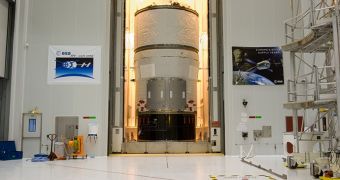As it turns out, not only NASA has problems with the launch of its spacecraft. It seems that the European Space Agency is currently experiencing some technical difficulties with its Automated Transfer Vehicle, the Jules Verne, and will need to delay the launch sequence by one day in order to fix them. According to the ESA, the problems are related to the launcher separation system coordinating the ATV/Ariane 5 spacecraft.
Jules Verne was supposed to launch from the Kourou launch facility, in the French Guiana on the 8th of March, at 05.23 CET. Arianespace has issued a press statement today saying that the launch of the spacecraft has been re-scheduled for the 9th of March, 04:59 CET. During the last check of the device, ESA engineers discovered a potential fitting problem on the grounding straps located on the separation system. Thus today, the ATV was removed from the top of the Ariane 5 rocket for a systematic check, to ensure that the system is working properly during the separation stage.
The Jules Verne ATV has been built by the EADS-Astrium company to replace the Russian-built Progress freighters carrying supplies to the International Space Station. It is the most powerful re-supply ship ever build and makes use of an automatic propulsion and navigation system which will dock it to the Russian Service Module without human intervention. It is carrying 9 tons worth of spare parts, water, food, oxygen and a set of scientific experiments and equipment essential for the maintenance of the International Space Station.
Upon delivering its precious cargo, the ATV will remain docked to the Service Module as long as six months, to act as a waste disposal unit, before being de-orbited and sent into Earth's atmosphere with up to 6.3 tons of waste no longer essential to the ISS crew. A precisely controlled re-entry will ensure that the waste and the ATV itself will burn into the atmosphere before reaching low altitudes.

 14 DAY TRIAL //
14 DAY TRIAL //